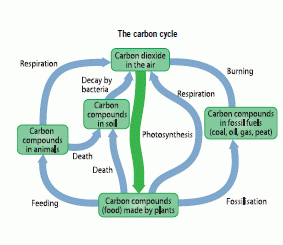The Atmosphere
Absorption of Radiation
The Earth is surrounded by an atmosphere made up of different gases. It allows some frequencies of electromagnetic radiation from the Sun to pass through.
The Earth emits infrared radiation at lower frequencies. These frequencies are absorbed by some gases in the atmosphere such as carbon dioxide, water vapour and methane. This keeps the Earth warm and is called the atmospheric greenhouse effect. Without it the Earth would be much colder – too cold for some species to survive.
Build Your Understanding - High energy infrared and visible radiation from the Sun passes through the glass into a greenhouse. Low energy infrared radiation from inside the greenhouse cannot escape through the glass. This keeps the greenhouse warm and is called the greenhouse effect.
Global Warming
Scientists agree that global warming is happening. The Earth is getting warmer. In the last 200 years the amount of carbon dioxide in the atmosphere has steadily increased. Reasons include:
- Burning fossil fuels.
- Clearing forests so that fewer trees are using carbon dioxide for photosynthesis.
Computer climate models show that human activities are increasing greenhouse gases and causing global warming, but some scientists do not agree. They do not agree about how much change is likely and what effect it will have. It could result in:
- Extreme weather conditions in some regions.
- Rising sea levels due to melting ice and expansion of water in oceans which may flood low lying land.
- Some regions no longer able to grow food crops.

Ultraviolet in the Atmosphere
Some ultraviolet radiation from the Sun reaches the surface of the Earth but, fortunately for living things, the highest energy (highest frequency) ultraviolet radiation is stopped by the ozone layer.
This is a layer of ozone gas in the upper atmosphere that absorbs ultraviolet radiation and chemical changes occur. Without this layer higher frequency ultraviolet would cause more sunburn, skin cancer and cataracts.
In 1985 an ozone hole was discovered above the Antarctic. Scientists had been looking for a reduction in the ozone layer, but did not expect to find a large hole that formed so quickly.
The measurements were repeated with new equipment. They were replicated by the scientists who discovered the hole and reproduced by other scientists. Where the ozone layer has been depleted, living organisms, especially animals, suffer more harmful effects from ultraviolet radiation.

Scientists believe that the ozone hole was caused by people using CFC gases in aerosol cans. As well as the refrigerant in refrigerators and freezers, causing the concentration of CFC gas in the atmosphere to increase. This pollution reacted with the ozone in the springtime and reduced the amount in the ozone layer. Scientists predicted that the ozone hole would grow. This prediction was correct.
International agreements, like the Montreal Protocol in 1987, have stopped the use of CFCs and other ozone depleting gases. This is a good example of the world’s governments working together. The ban is having an effect and the hole is getting smaller, but the CFCs are very stable so it will be at least 50 years before the hole disappears.

